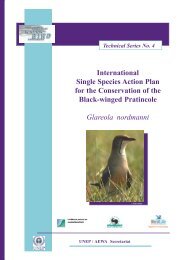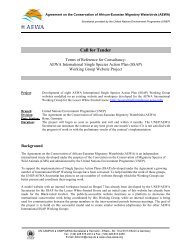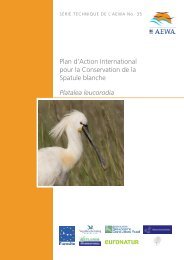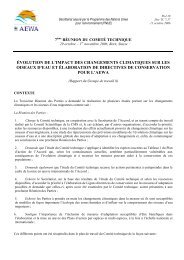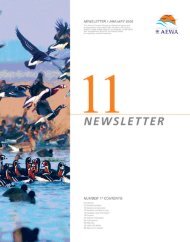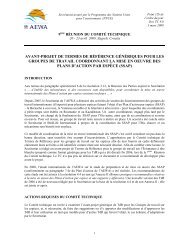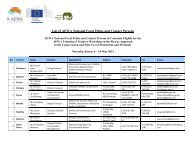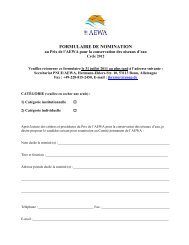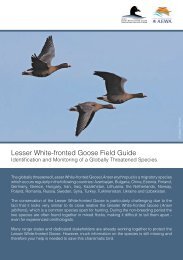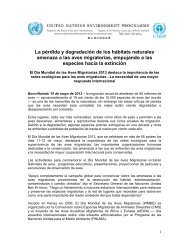International Single Species Action Plan for the ... - AEWA
International Single Species Action Plan for the ... - AEWA
International Single Species Action Plan for the ... - AEWA
Create successful ePaper yourself
Turn your PDF publications into a flip-book with our unique Google optimized e-Paper software.
<strong>AEWA</strong> Technical Series No. 36 - Annexes<br />
Annex 9b<br />
Additional independent comments by Dr Robert C. Lacy, November 2005.<br />
Comments on <strong>the</strong> genetic issues related to <strong>the</strong> new <strong>Action</strong> <strong>Plan</strong> <strong>for</strong> <strong>the</strong> Lesser Whitefronted<br />
Goose (LWfG)<br />
Robert C Lacy, PhD<br />
Population Geneticist/Conservation Biologist<br />
Chicago Zoological Society<br />
Chair<br />
IUCN/SSC Conservation Breeding Specialist Group<br />
Committee on Evolutionary Biology<br />
University of Chicago<br />
I will preface my remarks by stating that I have not be<strong>for</strong>e been involved in any of <strong>the</strong><br />
discussions or analyses of <strong>the</strong> LWfG or any related species. My comments below are in<br />
response to <strong>the</strong> set of documents sent to me by Sergey Dereliev of <strong>the</strong> UNEP/<strong>AEWA</strong><br />
Secretariat.<br />
My background is that I was trained as an evolutionary biologist, with work in population<br />
genetics, ecological genetics, and behavioral genetics. I have worked <strong>for</strong> <strong>the</strong> past 20 years as a<br />
conservation geneticist <strong>for</strong> <strong>the</strong> Chicago Zoological Society, with adjunct faculty positions at<br />
<strong>the</strong> University of Chicago and University of Illinois. My research has included: experimental<br />
studies of <strong>the</strong> effects of inbreeding and intercrossing on Peromyscus mice; analyses of <strong>the</strong><br />
genetic changes and inbreeding effects that occur in captive breeding programs <strong>for</strong> wildlife<br />
species; development of statistical techniques <strong>for</strong> pedigree analysis and <strong>the</strong> management of<br />
breeding programs; and development of computer simulation models <strong>for</strong> population viability<br />
analysis <strong>for</strong> assessing threats to wildlife populations and testing <strong>the</strong> likely impacts of<br />
proposed management actions. I have taught short courses to wildlife managers and zoo<br />
biologists on <strong>the</strong> genetic management of endangered species. For <strong>the</strong> past 3 years, I have<br />
served as <strong>the</strong> chairman of <strong>the</strong> IUCN/SSC Conservation Breeding Specialist Group – <strong>the</strong><br />
network of experts who provide technical assistance on matters related to use of captive<br />
breeding programs to serve species conservation, and related programs of intensive<br />
population management. I have provided advice to government agencies on <strong>the</strong> genetic<br />
management and recovery plans <strong>for</strong> whooping cranes, Puerto Rican parrots, and three<br />
penguin species, and also <strong>for</strong> many species of mammals (e.g., black-footed ferrets, beach<br />
mice, and Florida pan<strong>the</strong>rs in <strong>the</strong> USA, eastern barred bandicoots and Leadbeater’s possums<br />
in Australia, and all five extant species of rhinoceros), and a few reptile and amphibian<br />
species.<br />
It is not clear to me if <strong>the</strong> primary disagreement about <strong>the</strong> genetic issues related to<br />
conservation actions <strong>for</strong> <strong>the</strong> LWfG is due to different opinions about <strong>the</strong> genetic data and<br />
analyses, or to different interpretations of <strong>the</strong> implications of those data <strong>for</strong> conservation, or to<br />
both <strong>the</strong> data and <strong>the</strong> conservation implications. With respect to <strong>the</strong> data <strong>the</strong>mselves, it seems<br />
to me that with <strong>the</strong> most recent molecular genetic analyses, <strong>the</strong> genetic characterization of <strong>the</strong><br />
LWfG is becoming clear (although I expect that some of those involved in <strong>the</strong> debates may<br />
still disagree with parts of my description of <strong>the</strong> in<strong>for</strong>mation now available).<br />
The mitochondrial DNA data show that two divergent clusters (each with a primary common<br />
type and a number of variants that differ only by one or two mutations of likely recent origin)<br />
of mtDNA haplotypes occur in <strong>the</strong> wild populations of LWfG, and an additional two general<br />
<strong>International</strong> <strong>Single</strong> <strong>Species</strong> <strong>Action</strong> <strong>Plan</strong> Lesser White-fronted Goose –Annexes XLVIII



